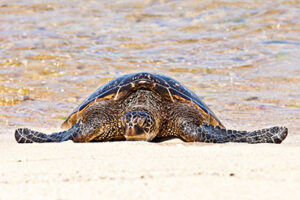Hawaiian Green Sea Turtle

The Hawaiian Green Sea Turtle (honu) was listed as a threatened species in 1978 under the U.S. Endangered Species Act of 1973. Hawaii State law has protected the green sea turtle since 1974. As a result, the Hawaiian Green Sea Turtle population has increased 53% over the last 25 years, despite an overall decline globally.
The state and federal laws prohibit harassing, harming, killing, or keeping sea turtles in captivity without a permit, allowing these activities for research or educational purposes.
Green turtles are found throughout the world, but the Hawaiian green turtle is genetically distinct from the other populations. This species was in a steep decline as of the 1970s because of direct harvest of both turtles and eggs by humans. The population has grown steadily over the last thirty years after protection began in 1978. In the early 1970’s a siting on the beach or in waters near shore would have been rare. Today, you can commonly see sea turtles on beaches, in the surf and while diving and snorkeling. But, in other areas of the Pacific, direct harvest remains a serious threat to green turtle populations.
Sea Turtle Facts
- Fibropapilomatosis is the primary threat to Hawaiian Green Sea Turtles. It is a disease which causes tumor growth on exposed soft tissue such as the head, neck and flippers. Tumors can impede turtles’ functions such as eating and ability to avoid predators.
- Other threats include habitat loss, ingestion of marine debris, entanglement and nest predation.
- A typical adult green turtle has a carapace length of 40 inches and can weigh from 200-500 lbs.
- Their lifespan is generally unknown, but is thought to be around 60-70 years.
- More than 90% of the Hawaiian population of green turtles nests at French Frigate Shoals in the Northwestern Hawaiian Islands. They migrate to feed mainly in the coastal areas of the Main Hawaiian Islands.
Viewing Guidelines
The Hawaiian Green Turtle commonly crawls ashore to bask on the beach in isolated sites. Basking is rare among other marine turtles.
- If you see sea turtles out basking on the beach or in the water while snorkeling, admire them from a reasonable distance and do not alter their natural behavior.
- Photograph them from a reasonable distance with a long telephoto lens
- Do not attempt to touch, feed or harass sea turtles.
- Riding turtles by divers is illegal and puts these animals under stress.
The website of Department of Land and Natural Resources, division of Aquatic Resources states that there is no law specifying a minimum distance for viewing turtles.(State of Hawaii Division of Natural Resources: http://dlnr.hawaii.gov/dar/species/sea-turtles/ ) The public is advised to keep a 10-foot buffer as a best practice. In some areas, volunteers monitor this practice. Although this viewing distance seems to be generally respected, it is a concern, especially at high visitor-use beaches where visitors sometimes approach turtles too closely.
Local Cultural Significance
Historically, sea turtles have played a large role in Hawaiian culture. Native peoples all over the Pacific utilized all parts of the turtle for food, and for making tools and jewelry out of the bones, and containers and utensils out of the carapace. Cultural artifacts, such as petroglyphs and tattoo designs feature artistic elements of green turtles
Today, honu symbolism is popular in Hawaiian art, crafts and design.
Portions of this article are Courtesy: Northwest Fisheries Science Center, NOAA Fisheries and State of Hawaii Division of Natural Resources
